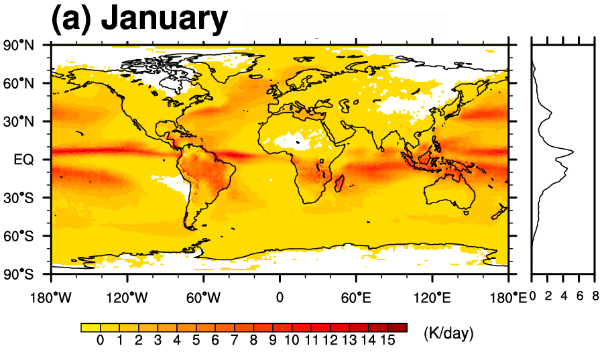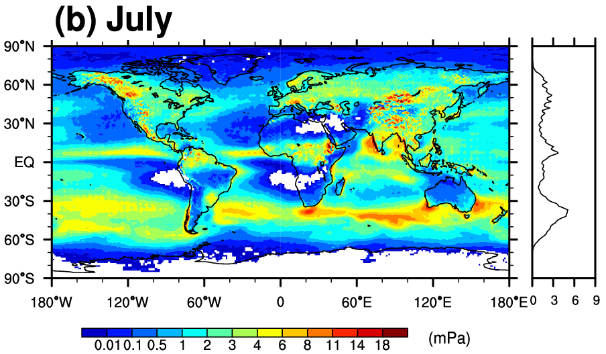<Convective Gravity Waves>
Momentum flux of convective gravity waves derived from an offline gravity wave parameterization
Vertically propagating gravity waves (GWs) transfer their momentum to large-scale flow in the middle atmosphere, where they dissipate. Among the various sources of GWs, convection can generate high-frequency GWs. Therefore, convective GWs (CGWs) have a broad phase speed spectrum and can propagate to higher altitudes without seasonal restrictions.
Small-scale gravity waves with horizontal wavelengths of few tens of kilometers are rarely detected from global observation, such as satellite data, and are not fully resolved by recent high-resolution general circulation models. In this respect, CGW momentum flux and drag derived from a physically based and source-dependent parameterization and global reanalysis data are calculated (Kang et al. 2017; Kang et al. 2018; Kang et al. 2020).




<Global distributions of column-maximum deep convective heating rate (left)
and cloud-top gravity wave momentum flux (CTMF, right) in (a) January and (b) July>
The cloud-top (source-level) CGW momentum flux (CTMF) is not solely proportional to the convective heating rate but is affected by the wave-filtering and resonance factor and background stability and temperature underlying the convection. Consequently, the primary peak of CTMF is in the winter hemisphere midlatitudes, associated with storm tracks, where a secondary peak of convective heating exists, whereas the secondary peak of CTMF appears in the summer hemisphere tropics and intertropical convergence zone, where the primary peak of convective heating exists.
The results of offline CGW momentum flux and drag results have been utilized to understand the variations in CGW drag for driving the quasi-biennial oscillation (QBO; Kang et al. 2018) and Brewer-Dobson circulation (BDC; Kang et al. 2020) They can be also utilized GCM simulations to constrain the magnitude of the CGW momentum flux at the source level and in the stratosphere.
Reference:
Kang, M.-J., H.-Y. Chun, and Y.-H. Kim, 2017: Momentum flux of convective gravity waves derived from an offline gravity wave parameterization. Part Ι: Spatiotemporal variations at source level. J. Atmos. Sci., 74, 3167–3189.
Kang, M.-J., H.-Y. Chun, Y.-H. Kim, P. Preusse, and M. Ern, 2018: Momentum flux of convective gravity waves derived from an offline gravity wave parameterization. Part ΙΙ: Impacts on the quasi-biennial oscillation. J. Atmos. Sci., 75, 3753–3775.
Kang, M.-J., H.-Y. Chun, and B.-G. Song, 2020: Contributions of convective and orographic gravity waves to the Brewer-Dobson circulation estimated from NCEP CFSR. J. Atmos. Sci., 77, 981–1000.
